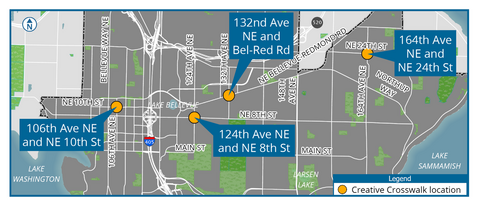The Transportation Department, in collaboration with the Community Development Department, is working on a pilot project to add artistic treatments to four crosswalks around the city. This work is being funded by a U.S. Department of Transportation Safe Streets and Roads for All grant plus funding from Community Development’s Arts and Culture program.
While the intent of the asphalt art is purely aesthetic, the project will evaluate how the artistic crosswalks compare to 12 control/no-treatment crosswalks. Performance measures may include safety, maintenance and community sentiments. This project will also help with the development of a guide for the future implementation of asphalt art.
The four intersections are:
- 164th Avenue Northeast and Northeast 24th Street
- 124th Avenue Northeast and Northeast Eighth Street
- 132nd Avenue Northeast and Bel-Red Road
- 106th Avenue Northeast and Northeast 10th Street
At each of these locations, one crosswalk will have a creative design applied and the other will remain without one, serving as a control for evaluations..
Artists
The city’s selection panel chose two artists for the Creative Crosswalk Designs project; each artist will design two crosswalks.
Nikita Ares
Nikita Ares (b. 1996, Cagayan de Oro, Philippines) is a Seattle-based visual artist whose work explores movement, energy, and the emotional landscape of the self through abstract painting and drawing. She immigrated to the United States at 17 and received a bachelor's degree in fine art from Cornish College of the Arts in 2018. Her work spans studio painting, public art and community-centered workshops, including murals that enliven spaces with vibrant presence. Ares has created outdoor murals across Washington and beyond, and she continues to expand her practice through collaborations and socially engaged projects.
Kenji Stoll
Kenji Stoll is a Tacoma-based artist with a background in design, graffiti art, murals and community-based public art. His work often layers patterns, natural imagery and motifs, informed by his Japanese American heritage and Japanese art. He enjoys working on public art projects because of their accessibility, and the ways they shape our shared understanding of who we are and where we live.
Timeline
- 2026-2027: Crosswalks will be evaluated compared to the control/no-treatment crosswalks and results will be analyzed.
- Summer 2026: Crosswalk art is scheduled to be installed.
- October 2025: Art designs for the crosswalk complete.
- Summer 2025: Community outreach and development of design. More information on outreach will be available on this webpage.
- April-May 2025: Artist selection

